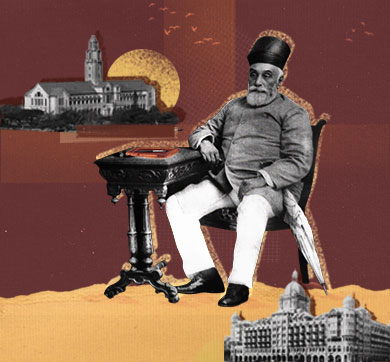March 2023 | 1058 words | 3-minute read
The long-expected day had arrived. Before dawn, the tiny twinkling stars began to hide, and the wee small hours of the autumn morn, were witness of enthusiastic activities of thousands of people—old, young—male and female. Crowds of people, with flowers, garlands in hand, clothed in garments of different fashions and colours, singing and dancing, were seen moving merrily from every part of the city, and by six o'clock in the morning, the TISCO Mill premises were crowded with people.”
This description of Founder’s Day in 1933, as written by an employee of Tata Steel, was published in the TISCO Review of April 1933. The idea was conceived by the then Chief Accountant of Tata Steel, D M Madan. The editorial of the Review stated: “The late Mr D M Madan first conceived the idea of holding an annual demonstration that should give each member of the whole staff an opportunity of expressing his regard for the memory of the genius to whose faith and judgement, energy and perseverance, the works and towns of Jamshedpur and its environs bear enduring witness. At the same time the ceremony was devised so as to enable each worker to demonstrate his pride of membership in an organisation already so potent, and burgeoning with the promise of a new India.”

The procession
The central feature of the morning’s celebration was a procession by factory workers towards the statue of Jamsetji:
“The officers of the various departments arranged their men in front of their respective offices and places of work, and each troop marched with slow and measured tread singing in praise of the great patriot, and the Company. One contingent after another marched to the statue of our great benefactor, the late Mr. J. N. Tata, with flags, flowers, and banners, and deposited them in front of the statue, and paid their true and sincere homage to the benefactor of humanity and marched out through the Main Gate, where people from far and near gathered in huge crowds to witness the procession.
In every face, there was seen true devotion and great veneration to the departed patriot.
By noon, the statue presented a very picturesque sight, the flowers thrown in front and around it having reached to the height of the shoulders.”

Illumination and fireworks
Founder’s Day was first observed in 1932. The 1933 celebrations were on the same pattern as the previous year’s, which give us a fair idea of how the first ever Founder’s Day was observed in Jamshedpur. The festivities continued throughout the day with large crowds of visitors – workers, their families, and other townspeople – visiting the statue and paying their floral respects till late into the night.
The illuminations lighted up the statue and the factory premises in the evening, as did other buildings of Jamshedpur:
“Everything was splendidly arranged and managed within the Works, while the illuminations specially arranged at selected places, bungalows, schools and shops added pleasure and harmony to the full hearts of the public.”
In the evening of March 4, the town was treated to a fireworks display.


A description in verse
The Review also carries a poem that describes the procession, an excerpt of which is below:
‘Twas Friday morn the 3rd of March, I heard the Church bells peal,
And buzzers sounding long drawn blasts, a tremor I did feel,
But soon it passed and then a thought that it was Founder’s Day,
Soon flashed across my dormant mind, all homage due to pay.
The sun shone bright on Tata's works, inside there was a bustle,
Departments quickly formed in groups with eagerness and hustle,
As all in column were to move, with reverence complete,
To lay their floral tributes at our Benefactor's feet.
And now in close formation dressed with colours gay and bright.
Came all our workmen clan by clan. It was a splendid sight.
Each had a banner at their head, and on it some device,
Depicting something of their thought, so pleasing to the eyes.
First came the Offices and Town with draftsmen in between,
Whose banner showed a map well traced and on it could be seen,
Our Founder's likeness on the right, a workshop on the left,
Neat drawn by one whose willing heart and hands which proved so deft.
And as they passed the Founder's bust, they placed with solemn grace,
Their floral tributes on the grass, right at the Statue's base
While songs of praise were sung with awe, they slowly moved away,
For other groups their turn await, their homages to pay.
Next comes with steady pace and gait our unit number two,
With flags and bunting waving proud and several banners too,
The Mill-Write, Paint, and Welding ships, the Ice and Soda Plant,
The Machine Shops and Motor Shed, the Blacksmiths and their band.
The Smithies were conspicuous with garland raised on high
Which round the neck of Tata's bust they placed with reverent sigh,
This garland made of flowers fresh with letters boldly raised
While eager throats his mighty work in joyous songs they praised.
Their work being done they also moved and other groups soon followed,
While music strains from various pipes which human hands had hollowed,
Came wafting through the gentle breeze, accompanied with song
The Foundries and the Pattern Ships, the Stores and Pipe Line West,
The Loco Shed and Loco Cranes all looking their best.
And while they did their little all the next group came in sight,
With banner bearing strange device showing Powers rightful might,
For perched upon some objects round, which boilers indicated,
The figure of a lion sat, a clever sign dictated.
More photos





- Text by Haroon Bijli. Archival material and photographs courtesy Tata Steel Archives.













